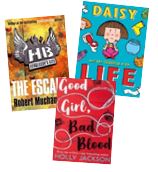Tameside Virtual School and College Loves Reading
Reading Suggestions
 Children’s reading skills vary so it’s important to choose a book that is accessible and suitable for the individual. Here is our suggested reading list for primary and secondary school children – Reading List
Children’s reading skills vary so it’s important to choose a book that is accessible and suitable for the individual. Here is our suggested reading list for primary and secondary school children – Reading ListIf your child has SEND and requires adapted books to ensure they can access reading, please contact us: admin.virtualschool@tameside.gov.uk – we will endeavour to find suitable books for their ability and needs.
Useful Resources for Support
The National Literacy Trust has lots of advice and activities that may help you support and engage your child in reading and learning at home - Words for Life – National Literacy Trust
Another great site to find hints and tips on how to engage young readers - Tameside Loves Reading
Advice:
10 top tips for parents to support children to read - GOV.UK (www.gov.uk)
- How to encourage children to read in foster care | Capstone Foster Care
- Tips for reading with your child | BookTrust
- Tips on reading books with your child | Words for Life
- Practise phonics with your child | Words for Life
- Magazines and comics for young readers | Words for Life
- Book suggestions for 3-12 year olds | Words for Life
- The benefits of reading to a pet or child | Words for Life
Engaging and Supporting Your Child with Reading at Home
Here are 5 ways to encourage reading with children and young people at home…
- Introduce reading at an early age
- You should introduce reading to a child at the earliest possible age – they are never too young! It will allow children to become familiar with the activity, especially if you make it an exciting part of their daily routine
- Exploring pictures and illustrations in a book, as well as reading to a young child, helps develop imagination – not forgetting making it more fun
- With cared for children, we know this isn’t always possible if you start fostering children of different ages but introducing it into the home at any point will still be beneficial
- Join the local library
- Taking a trip to the library can be a really exciting experience for children
- It allows them to explore the different choices that are out there – from picture books to sci-fi novels, there will always be lots of new and popular books in your local library for children to choose from
- Read to your child regularly
- Try to ensure you read to your child everyday
- Create a routine and embed it into the daily routine – this could be before bedtime or a quiet afternoon at the weekend
Create a calm and comfortable reading environment
- When reading to your child at home, ensure there is a quiet and comfortable space to do so
- This will avoid any distractions, and will hopefully keep them engaged for longer
- If a child is able to read independently at home, you could create a quiet hide away where they can get lost in their favourite book!
- Finally, be a role model…
- Make sure you read at home, even if it is a magazine or newspaper, showing children that you enjoy reading is setting a good example – hopefully giving them more encouragement to do it themselves!
- Also, have discussions around reading and books at home – at dinner time, when playing or socialising with the family

